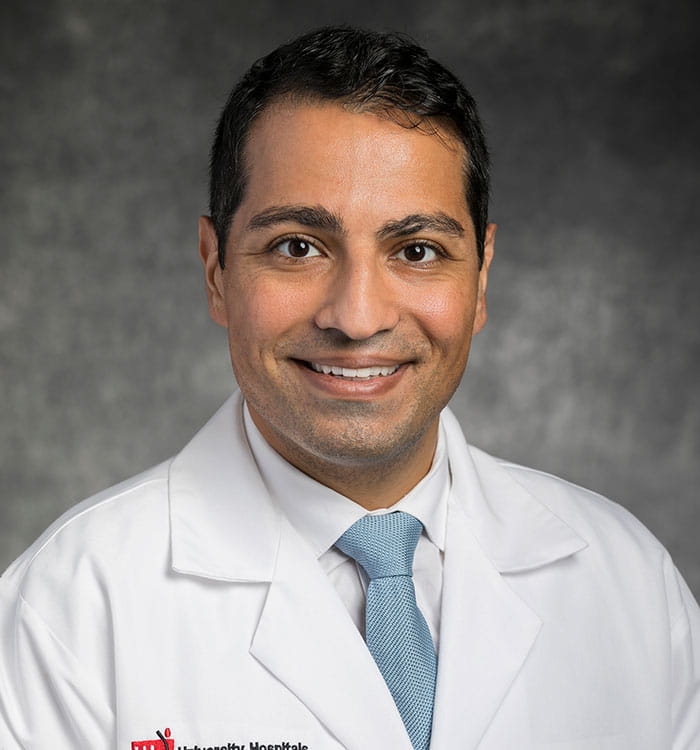Facial Plastic Surgeon Joins University Hospitals
October 26, 2020
A Q&A with Cyrus Rabbani, MD
UH Clinical Update | October 2020
 Cyrus Rabbani, MD
Cyrus Rabbani, MDCyrus Rabbani, MD, facial plastic and reconstructive surgeon in the Department of Otolaryngology – Head and Neck Surgery at University Hospitals, and Assistant Professor at Case Western Reserve University School of Medicine, earned his medical degree at Wayne State University School of Medicine. He completed residency training in otolaryngology at Indiana University and completed fellowship training in facial plastic surgery at Johns Hopkins. Here, he responds to questions from UH Clinical Update:
Q: How long have you been at UH? Talk a little bit about why you opted for a position here.
A: I have been at University Hospitals for two months now. This is my first position after completing fellowship this past year. The process in selecting a job was both nerve-wracking and exciting. The position here provides me the resources to build a robust facial plastic and reconstructive surgery program in a collaborative academic center that shares a commitment to scholarship, service and professionalism.
Q: Discuss the different types of patients you see in your practice. What’s the most challenging thing about performing surgery for each of these groups?
A: There is a wide range of patients I see for both reconstructive and cosmetic surgery. I tend to treat my patients with a focus on their particular needs and goals. When it comes down to it, each patient requires an individually stylized plan that focuses both on cosmetic and functional outcomes. This includes patients with congenital anomalies, facial paralysis, facial fractures, or those who desire aesthetic changes. The challenge of surgery in any form, cosmetic or reconstructive, is achieving an outcome that not only fulfills the desires of the patient, but exceeds their expectations and becomes a part of their life history as a meaningful change.
Q: What are some recent developments and trends in facial plastic surgery that would be of interest to fellow healthcare providers?
A: There are techniques in facial plastic surgery that have remained tried and true. That being said, there has been an evolution in how we approach numerous operations including facelift, rhinoplasty, nasal reconstruction and facial reanimation over the past few decades. For example, recent approaches to synkinesis in facial paralysis patients have led to selective neurolysis of nerves that are “bad actors,” whereas previously chemodenervation (e.g. “Botox”) or muscle myectomy were considered the main options. This is why I find it critical to be an active member and participant in national society and academic meetings in order to remain up to date and contribute to progress in this specialized field.
Q: Are there any myths or misconceptions that people have about facial plastic surgery, even healthcare providers?
I would say that most people who are unfamiliar with the specialty consider the scope of care to be geared towards aesthetic surgery such as facelift, rhinoplasty and blepharoplasty. However, I would like to elaborate that my specialty’s philosophy is based on a reconstructive approach with an aesthetic finish. This means that every operation is meant to provide the patient with an aesthetically favorable outcome while strictly adhering to reconstructive principles, whether it be for facial trauma, congenital anomalies, facial paralysis, or cosmetic surgery.
Q: Where do you see patients and perform surgery at UH?
I am rather geographically diverse in my clinical and surgical practice across UH. I hold clinics at UH Westlake, UH Minoff, UH Suburban, UH Seidman Cancer Center, and the Zagara pediatric subspecialty office at UH Rainbow. My surgical sites include operating time at the Prentiss, Mather, Westlake and Richmond facilities. I am excited to offer patients care across the greater Cleveland area. I can guarantee patients will feel a strong sense of guidance and comfort from my care. This strong communication will extend to the other providers and caregivers on whom these patients depend.
Q: With people being very attached to their faces, it seems that creating a satisfying patient experience is critical for a facial plastic surgeon. What are some of the specific things you do with your patients to make sure they have the best experience possible?
A: Surgery on the face involves some high stakes. Our face is on display daily throughout our life, whether in public or on a video call these days. Patients need to know they have an advocate. I aim to establish an open and direct line of communication with my patients that make them feel they are well supported and receiving top tier care in capable hands. This is during all aspects of care, whether surgical or non-surgical.
For more information about Dr. Rabbani or to refer a patient, please call 216-844-6000.
Tags: Plastic Surgery, Cyrus Rabbani, MD


